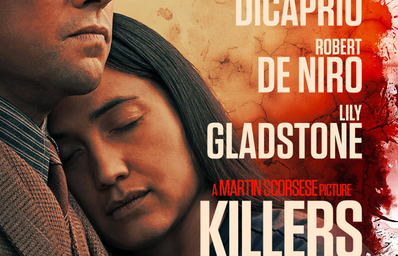Warning: This article contains major spoilers for “Killers of the Flower Moon” (2023)
“There was no mention of the murders,” is the final line delivered in “Killers of the Flower Moon” by director Martin Scorsese as he narrates the obituary of Mollie Burkhart (Lily Gladstone). It’s a harrowing moment that affirms William “King” Hale’s (Robert De Niro) assessment of how the American public will react to the Osage Indian murders: “People forget. They don’t remember, they don’t care. They just don’t care.” Yet even with the agonizing violence and tragedy that permeates this film, its endmost shot puts the resilience of the Osage people at the forefront of the narrative, making for a powerful conclusion that will no doubt linger in the audiences’ mind well after they have left the theater.
“Killers of the Flower Moon” is a historical epic that centers on the “Reign of Terror” inflicted upon the Osage people in Oklahoma from 1918 to 1931. It is based on the bestselling non-fiction novel by David Grann. Following the discovery of oil in their indigenous territory, Osage Natives acquired a hefty fortune. Motivated by greed, white conspirators systematically murdered dozens of Osage men and women in order to steal their wealth and land.
The beating heart of this film is undoubtedly Mollie Burkhart, who endures the loss of her sisters Anna, Reta and Minnie in a scheme concocted by William Hale to procure her family’s fortune. Mollie’s husband, Ernest Burkhart (Leonardo DiCaprio), is Hale’s nephew and actively contributes to the fruition of the murder plot. Lily Gladstone’s performance throughout the film is utterly haunting and heart-wrenching. Her expressions of subdued rage are permanently seared into my mind, along with her guttural screams of anguish.
Scorsese’s filmography has always examined manifestations of evil in the real world, whether it be the heartless gangsters in “Goodfellas” or the conniving grifters in “The Wolf of Wall Street.” Greed, to Scorsese, is what drives humans to commit the most heinous acts in the world. He typically hides this darkness under layers of excess and glamor (see: “Casino”) as a representation of American capitalism. In “Killers of the Flower Moon,” there is no tantalizing veil that conceals the rot – there’s just rot. Within the film’s opening moments, the audience witnesses the horrifying deaths of the Osage Natives that went ignored by the public and law enforcement. The perpetrators of these murders aren’t hindered by a guilty conscience and the acts are carried out with a heavy silence, placing the banality of evil on full display.
Ernest is perhaps one of Scorsese’s most terrifying depictions of evil. Throughout the film, he is portrayed as an ultimately self-serving, vapid man. His spineless nature allows him to become a pathetic pawn in Hale’s game. Despite his guilt, Ernest continues to act at his uncle’s behest and commit repulsive acts, including slowly poisoning his wife. He convinces himself that his love for Mollie absolves him of his crimes, and yet he can’t stop hurting her.
In the end, whatever internal turmoil Ernest experiences is simply not enough. Scorsese thus posits the idea that evil is something that people can always rationalize as a necessity, regardless of its scale and extremity.
“Killers of the Flower Moon” provides a paralyzing viewing experience. The audience is forced to reckon with the undeniable rot that the American empire is built upon. As you watch tragedy after tragedy unfold, a pit continues to grow in your stomach. There’s a distinct shot of Reta’s husband, Bill Smith, lodged underneath the wooden remains of their house after it has been blown up. His figure is bloodied and his eyes appear to be blinded from the blast. “Shoot me! Shoot me, please!” he begs to be put out of his misery, no doubt mirroring the state of the viewer after witnessing the non-stop brutality of this film.
The fire sequence in “Killers of the Flower Moon” where Hale and his men burn the land in order to receive a 30,000 dollar insurance policy provides one of the film’s most striking visuals. Remaining true to his Catholic upbringing, Scorsese portrays a state of damnation through the orange flames and the dark silhouettes that continue to violate the land. This allusion to hell is a grim reminder of the white settlers’ insidious nature and the agony that they have brought upon the Osage people. It’s an absolutely horrifying sight that acts as a direct contrast to the previously shown luscious, green hills sprawling with flowers. Through this sequence, Scorsese highlights the catastrophic greed of colonization and the subsequent destruction it causes.
Scorsese takes a provocative leap with the final stretch of “Killers of the Flower Moon” and provides a phenomenal ending. Enter the 1950s – decades after the atrocities have been committed. The Osage murders and Hale’s trial is being performed as a radio drama with exaggerated voice acting and silly sound effects. It’s a representation of the modern ‘true crime’ industry, a genre that thrives off of turning real life tragedies into voyeuristic entertainment fodder. The cruelty that the Osage have undergone has been commodified for a white audience. Scorsese’s involvement in the scene itself brilliantly breaks the fourth wall and shines a light onto his own complex feelings towards the limitations of the film. He acknowledges that his lack of Osage descent makes it difficult to tell their story in a way that doesn’t hinge on exploitation, thus implicating both himself and the audience. Overall, it provides a nuanced meditation that recontextualizes the entire movie as a whole. This is Scorsese at his most honest and vulnerable. By ending the movie on a shot of the Osage dancing in the modern day, Scorsese passes the torch to the perspective that the story should be honoring and celebrating. It acts as a beautiful symbol of the Osage’s endurance despite experiencing unimaginable tragedy.
“Killers of the Flower Moon” is a masterpiece that you must watch in theaters. Scorsese’s skillful attention to detail and direction is a sight to behold. Furthermore, the film features remarkable performances from Gladstone, De Niro, and DiCaprio that will no doubt put them in the Academy’s radar for the upcoming Oscar season. This film will certainly leave a profound impression on you and a painful ache in your heart. “Killers of the Flower Moon” has certainly earned its position at the top of Scorsese’s filmography.
One thing that couldn’t leave my mind as I watched the film was how its depiction of Indigenous struggle is so heavily intertwined with what is occurring in Palestine now. A deep theme of complicity runs throughout the narrative of “Killers of the Flower Moon” and the audience must reckon with how anyone could turn a blind eye to such blatant barbarity. According to the Palestinian Health Ministry, 5,791 people have been killed in Gaza, including 2,009 children. Israel’s unrelenting bombardment of the Gaza Strip is inhumane and must be condemned. If you are interested in sending aid to Palestinians, you can donate here.
There is a sentence written outside the walls of the Al-Yarmouk Palestinian refugee camp in Damascus, Syria that feels especially poignant after watching “Killers of the Flower Moon.” Printed in Arabic, it reads: “Killing the flowers will not delay the spring.”



